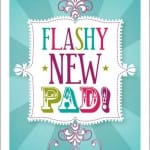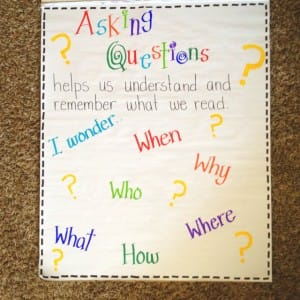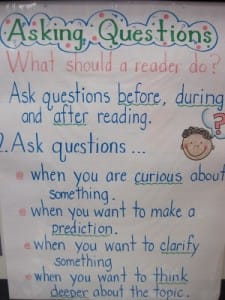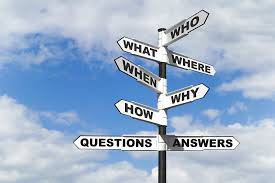Questions are Guaranteed…Answers Aren’t
Posted by Brainspring on 31st Mar 2014
Hello everyone!
 I’m glad you found our new home here on RLACortongillingham.com. I know I promised more March is Reading Month, but I wanted to wait until after the blog moved to post more. I’ll have to do something special to make it up to everyone. Maybe a list of 31 reading activities, one for each day in March? What do you think?
I’m glad you found our new home here on RLACortongillingham.com. I know I promised more March is Reading Month, but I wanted to wait until after the blog moved to post more. I’ll have to do something special to make it up to everyone. Maybe a list of 31 reading activities, one for each day in March? What do you think?
Right now though, I want to share a reading comprehension activity that can be used with any grade and any book. (It would make a great month-long activity for March is Reading Month…or any month!) The credit for this idea goes to Stephanie Cork, an amazing RLAC instructor and all-around reading rock star. At a recent workshop I attended she talked about doing this with her daughter a few years back and I thought it would be perfect to use with a classroom as well.
Read a book focusing on Questioning Skills
I know it sounds simple, but questioning is an important comprehension skill and encourages students to become active readers. Depending on the age level, you can adjust your focus and expectations for what defines a good question. For example, first and second graders may focus on using question words such as who, what, why, when and how; middle school students may focus on questioning the author’s thinking.
I remember doing a set of lessons on comprehension strategies when I was a student teacher in 5th grade. The questioning lessons were hands down the students’ favorite. I don’t even think they realized we were working on a comprehension skill because asking questions seemed so natural and interesting. Students are naturally curious- just think of all the things they ask about on a daily basis! Now, think of how powerful it could be to harness that curiosity and apply it to reading.
Post the funniest question you were asked this week. Mine comes from a first-grader who asked me earlier today, “How come your teeth are so white?”
To begin harnessing the power of students’ curiosity all they need is something to read. It can be fiction or nonfiction, an article or a novel, something the whole class is reading or something each student chooses individually. That being said, to begin with I do suggest using something the students chose, individually or voted on as a class. Letting them choose will help keep them engaged and interested; later, when students have had more practice with questioning they can be asked to apply their skills to other texts. I also suggest using a chapter book or a short novel, something that will take several weeks to read, because that will allow time for the students to practice and develop their questioning skills. Whatever text you choose, try to use it only for this activity. The purpose is developing questioning skills to deepen understanding and engagement. Too many additional activities, like summaries and book reports, will take attention and effort away from questioning and may turn the text into a chore instead of something the students look forward to.
 Once the students have their book, you’re ready to begin! Make it exciting for students. They get to read a whole book just asking questions and reading to discover the answers- how fun! Have a class discussion about asking questions and guide them to develop some guidelines for good questions. Create an anchor chart of what makes a good question for the students to refer to and add to throughout the process. This is where you can narrow the focus and emphasize a more specific aspect of questioning appropriate for your class.
Once the students have their book, you’re ready to begin! Make it exciting for students. They get to read a whole book just asking questions and reading to discover the answers- how fun! Have a class discussion about asking questions and guide them to develop some guidelines for good questions. Create an anchor chart of what makes a good question for the students to refer to and add to throughout the process. This is where you can narrow the focus and emphasize a more specific aspect of questioning appropriate for your class.
It’s important for the students to understand that questioning can be used any time they have a text: before, during and after reading. So your students should start developing their questioning skills before  you even open the book. They can generate questions based on the cover picture, title, author and any information on the back. This will also help them activate their background knowledge and generate an interest and investment in the reading. Make a class list of their questions. You may want to record them on a chart with the headings Who, What, Where, When, Why and How to encourage engaging questions. Try to avoid questions that can be answered with “yes” or “no”.
you even open the book. They can generate questions based on the cover picture, title, author and any information on the back. This will also help them activate their background knowledge and generate an interest and investment in the reading. Make a class list of their questions. You may want to record them on a chart with the headings Who, What, Where, When, Why and How to encourage engaging questions. Try to avoid questions that can be answered with “yes” or “no”.
Then…begin reading! Students should be encouraged to look for answers and develop new questions all through the process. One way you could do this is by having students stop after every chapter to see what questions they can answer and then form new questions. Students could also stop after every set number of pages or every set minutes of reading. The important thing is for students to keep checking in on their old questions and generating new ones. After the initial set of before reading questions, the students can continue the process individually, in pairs or groups. Then your class discussion can be directed by questions you ask the students. Here are some examples of open-ended questions you may want to try:
What questions were you able to answer and which questions weren’t you able to?
Why did you ask those questions?
Why were you interested in finding out more about…?
Why do you think that your question wasn’t answered?
What do you think about when you’re coming up with questions?
Does anyone notice themselves asking more questions as they read that they didn’t write down?
When are other times you find yourself asking questions?
Why do we ask questions?
How do questions help us understand more?
The more questions your students ask and the more you talk about questioning, the more beneficial this activity will be for your students. The key to making this successful is to keep the focus only on questioning. It can be tempting to include other comprehension skills as well. Using all sorts of comprehension skills when reading is the ultimate goal, however, students need start developing each skill individually before being asked to use them in conjunction with other skills. What I love about doing something like this, is that it’s a skill your students will never stop using! They aren’t learning information for a test; they are learning how to become better learners.
